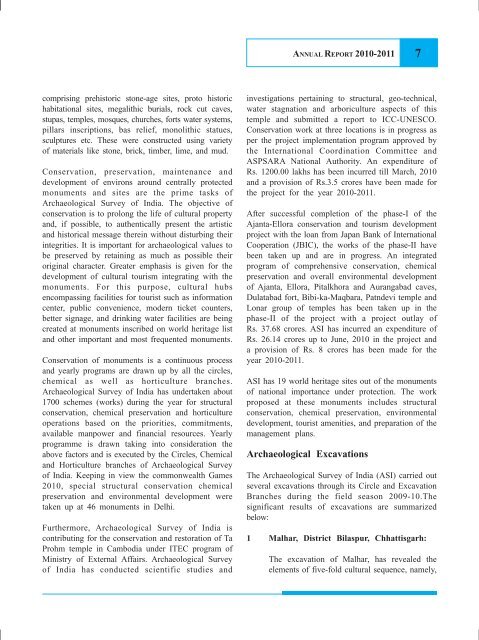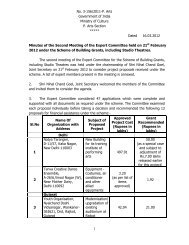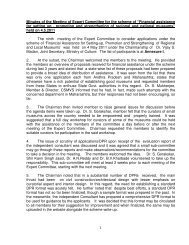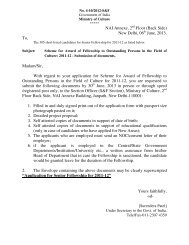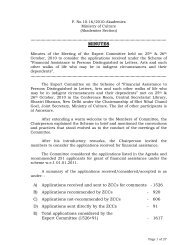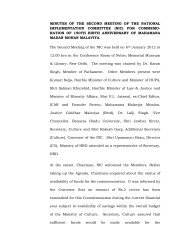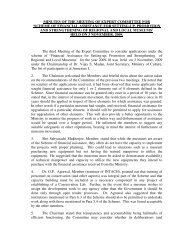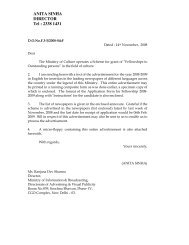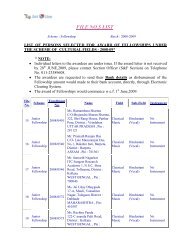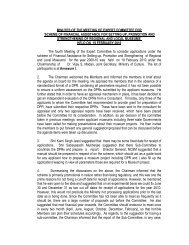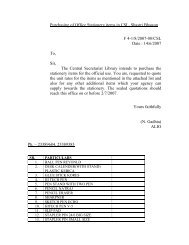Annual report - Ministry Of Culture
Annual report - Ministry Of Culture
Annual report - Ministry Of Culture
You also want an ePaper? Increase the reach of your titles
YUMPU automatically turns print PDFs into web optimized ePapers that Google loves.
comprising prehistoric stone-age sites, proto historic<br />
habitational sites, megalithic burials, rock cut caves,<br />
stupas, temples, mosques, churches, forts water systems,<br />
pillars inscriptions, bas relief, monolithic statues,<br />
sculptures etc. These were constructed using variety<br />
of materials like stone, brick, timber, lime, and mud.<br />
Conservation, preservation, maintenance and<br />
development of environs around centrally protected<br />
monuments and sites are the prime tasks of<br />
Archaeological Survey of India. The objective of<br />
conservation is to prolong the life of cultural property<br />
and, if possible, to authentically present the artistic<br />
and historical message therein without disturbing their<br />
integrities. It is important for archaeological values to<br />
be preserved by retaining as much as possible their<br />
original character. Greater emphasis is given for the<br />
development of cultural tourism integrating with the<br />
monuments. For this purpose, cultural hubs<br />
encompassing facilities for tourist such as information<br />
center, public convenience, modern ticket counters,<br />
better signage, and drinking water facilities are being<br />
created at monuments inscribed on world heritage list<br />
and other important and most frequented monuments.<br />
Conservation of monuments is a continuous process<br />
and yearly programs are drawn up by all the circles,<br />
chemical as well as horticulture branches.<br />
Archaeological Survey of India has undertaken about<br />
1700 schemes (works) during the year for structural<br />
conservation, chemical preservation and horticulture<br />
operations based on the priorities, commitments,<br />
available manpower and financial resources. Yearly<br />
programme is drawn taking into consideration the<br />
above factors and is executed by the Circles, Chemical<br />
and Horticulture branches of Archaeological Survey<br />
of India. Keeping in view the commonwealth Games<br />
2010, special structural conservation chemical<br />
preservation and environmental development were<br />
taken up at 46 monuments in Delhi.<br />
Furthermore, Archaeological Survey of India is<br />
contributing for the conservation and restoration of Ta<br />
Prohm temple in Cambodia under ITEC program of<br />
<strong>Ministry</strong> of External Affairs. Archaeological Survey<br />
of India has conducted scientific studies and<br />
ANNUAL REPORT 2010-2011 7<br />
investigations pertaining to structural, geo-technical,<br />
water stagnation and arboriculture aspects of this<br />
temple and submitted a <strong>report</strong> to ICC-UNESCO.<br />
Conservation work at three locations is in progress as<br />
per the project implementation program approved by<br />
the International Coordination Committee and<br />
ASPSARA National Authority. An expenditure of<br />
Rs. 1200.00 lakhs has been incurred till March, 2010<br />
and a provision of Rs.3.5 crores have been made for<br />
the project for the year 2010-2011.<br />
After successful completion of the phase-I of the<br />
Ajanta-Ellora conservation and tourism development<br />
project with the loan from Japan Bank of International<br />
Cooperation (JBIC), the works of the phase-II have<br />
been taken up and are in progress. An integrated<br />
program of comprehensive conservation, chemical<br />
preservation and overall environmental development<br />
of Ajanta, Ellora, Pitalkhora and Aurangabad caves,<br />
Dulatabad fort, Bibi-ka-Maqbara, Patndevi temple and<br />
Lonar group of temples has been taken up in the<br />
phase-II of the project with a project outlay of<br />
Rs. 37.68 crores. ASI has incurred an expenditure of<br />
Rs. 26.14 crores up to June, 2010 in the project and<br />
a provision of Rs. 8 crores has been made for the<br />
year 2010-2011.<br />
ASI has 19 world heritage sites out of the monuments<br />
of national importance under protection. The work<br />
proposed at these monuments includes structural<br />
conservation, chemical preservation, environmental<br />
development, tourist amenities, and preparation of the<br />
management plans.<br />
Archaeological Excavations<br />
The Archaeological Survey of India (ASI) carried out<br />
several excavations through its Circle and Excavation<br />
Branches during the field season 2009-10.The<br />
significant results of excavations are summarized<br />
below:<br />
1 Malhar, District Bilaspur, Chhattisgarh:<br />
The excavation of Malhar, has revealed the<br />
elements of five-fold cultural sequence, namely,


